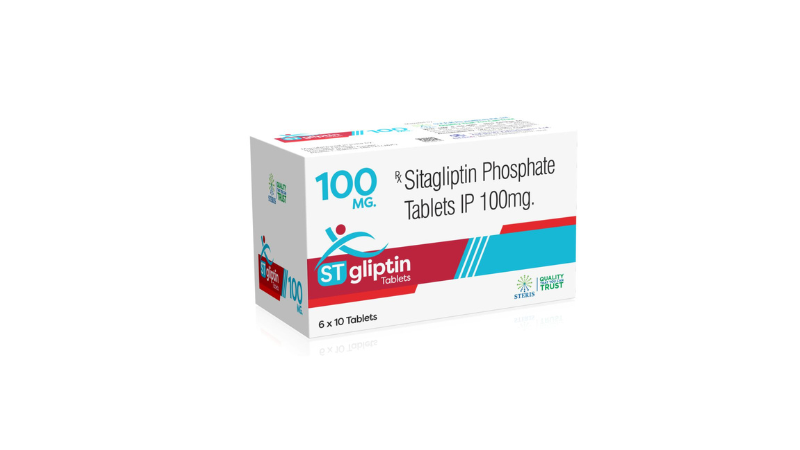"Sitagliptin 100mg: Comprehensive Diabetes Care"
May 31, 2024
Introduction
ST-GLIPTIN 100 contains Sitagliptin Phosphate 100 mg, an oral anti-diabetic medication used to manage Type 2 Diabetes Mellitus (T2DM). It works by regulating blood glucose levels and improving insulin response after meals. As a DPP-4 inhibitor, Sitagliptin is well tolerated and effective, especially when used as monotherapy or in combination with other anti-diabetic agents like Metformin, Sulfonylureas, or Insulin.
Sitagliptin 100 mg Tablet Uses
ST-GLIPTIN 100 is indicated for:
-
Type 2 Diabetes Mellitus (T2DM) in adults
-
Monotherapy in patients intolerant to Metformin
-
Combination therapy with other agents (Metformin, Sulfonylurea, Pioglitazone, or Insulin)
-
Improving glycemic control when diet and exercise alone are insufficient
Not recommended for Type 1 Diabetes or diabetic ketoacidosis.
Sitagliptin Mechanism of Action (MOA)
Sitagliptin is a DPP-4 (Dipeptidyl Peptidase-4) inhibitor.
MOA of Sitagliptin in Detail:
-
DPP-4 is an enzyme that degrades incretin hormones like GLP-1 (glucagon-like peptide-1) and GIP (glucose-dependent insulinotropic polypeptide).
-
Sitagliptin inhibits this enzyme, thereby increasing endogenous levels of GLP-1 and GIP.
-
Elevated GLP-1 and GIP enhance insulin secretion from pancreatic beta cells and suppress glucagon release from alpha cells in a glucose-dependent manner.
-
The net effect is reduced blood glucose levels—especially postprandial (after meals).
Glucose-dependent mechanism ensures a low risk of hypoglycemia.
Sitagliptin Dose and Administration
Recommended Dosage:
-
100 mg once daily with or without food
-
Can be taken at any time of the day, but preferably at the same time each day
Dose Adjustment Required in Renal Impairment:
| Renal Function (eGFR) | Sitagliptin Dose |
|---|---|
| ≥ 45 mL/min | 100 mg once daily |
| ≥ 30 to < 45 mL/min | 50 mg once daily |
| < 30 mL/min or ESRD | 25 mg once daily |
No dosage adjustment required in mild hepatic impairment.
Key Benefits of ST-GLIPTIN 100
-
Controls both fasting and post-meal glucose levels
-
Minimal risk of weight gain
-
Low hypoglycemia risk compared to sulfonylureas
-
Can be safely used in elderly patients
-
Oral once-daily dosage improves adherence
-
Compatible with various oral antidiabetic agents
Sitagliptin 100 mg Side Effects
Sitagliptin is generally well-tolerated. However, some patients may experience side effects:
Common Side Effects:
-
Upper respiratory tract infections
-
Nasopharyngitis (cold-like symptoms)
-
Headache
Less Common but Serious Side Effects:
-
Pancreatitis
-
Hypoglycemia (especially when used with sulfonylureas or insulin)
-
Allergic reactions (rash, urticaria, angioedema)
-
Joint pain
If you experience severe stomach pain, nausea, or signs of an allergic reaction, seek medical attention immediately.
Contraindications and Precautions
-
Not indicated for Type 1 diabetes or diabetic ketoacidosis
-
Use with caution in patients with:
-
Moderate to severe renal impairment
-
Pancreatitis history
-
Hypoglycemia risk (especially with insulin or sulfonylureas)
-
-
Not recommended during pregnancy or lactation without medical advice
Drug Interactions
-
May enhance hypoglycemic effect when combined with:
-
Insulin
-
Sulfonylureas (e.g., glipizide, glimepiride)
-
-
Use cautiously with drugs affecting renal function (e.g., NSAIDs, diuretics)
Storage Instructions
-
Store in a cool, dry place below 30°C
-
Keep away from direct sunlight and moisture
-
Keep out of reach of children
FAQs – Sitagliptin Phosphate 100 mg (ST-GLIPTIN 100)
Q1: What is Sitagliptin 100 mg used for?
A: Sitagliptin 100 mg is used to treat Type 2 Diabetes Mellitus by improving blood glucose control, especially post-meal levels.
Q2: What is the mechanism of action of Sitagliptin?
A: It inhibits DPP-4 enzyme, which increases GLP-1 and GIP hormone levels, thereby enhancing insulin secretion and reducing glucagon levels in a glucose-dependent manner.
Q3: Can Sitagliptin be used with Metformin?
A: Yes, Sitagliptin is commonly used in combination with Metformin for synergistic glycemic control.
Q4: Is Sitagliptin safe in renal patients?
A: Yes, but dosage adjustments are necessary depending on renal function.
Q5: Does Sitagliptin cause hypoglycemia?
A: Sitagliptin alone has a low risk of hypoglycemia. However, the risk increases when combined with sulfonylureas or insulin.
Q6: Can Sitagliptin help with weight loss?
A: Sitagliptin is weight neutral. It does not cause weight gain, which is beneficial for diabetic patients.
Q7: How long does Sitagliptin take to work?
A: Blood sugar levels may begin to improve within a few days, but optimal effect is usually seen after a few weeks of consistent use.
Conclusion
ST-GLIPTIN 100 delivers reliable and effective blood glucose control in adults with Type 2 Diabetes Mellitus, thanks to its scientifically backed DPP-4 inhibition mechanism. Its once-daily, well-tolerated formulation offers ease of use, excellent safety profile, and compatibility with multiple anti-diabetic regimens.
About The Author
Steris Healthcare Pvt Ltd, known as Sterispharma, was founded in February 2018 by a team of experienced professionals in the pharmaceutical industry. Headquartered in Navi Mumbai, the company holds certifications from WHO, GMP, and ISO, reflecting its dedication to maintaining high standards of quality and safety. Sterispharma’s mission is to provide affordable, high-quality medications across India, strictly adhering to WHO guidelines. With the convenience of an online pharmacy, customers can easily order medicines with home delivery options.
For further information
Email: info@sterispharma.com / contact@sterispharma.com
Call/WhatsApp: 8209542042 , 8824175417
Recent Post

Isosorbide Mononitrate 60 mg in Long-Term Angina Management: Role and Best Practices Steris Healthcare.

How Ribavirin Capsules Help in Treating Chronic Viral Infections Steris Healthcare.

Mefenamic Acid With Paracetamol Suspension Effective Relief for Pain and Fever in Kids Steris Healthcare.

Levosalbutamol and Ipratropium Bromide Respirator Solution Quick Relief for Wheezing & Tight Airways Steris Healthcare.

Levosalbutamol Respiratory Solution 0.31 mg Trusted Relief for Breathing Problems Steris Healthcare.

Sumatriptan Naproxen Tablets View Uses, Benefits, Dosage, Side Effects Steris Healthcare.

Megestrol Acetate 160 mg tablet: uses, dosage, side effects,

Telmisartan and Hydrochlorothiazide Tablet, Uses, Dosage, Benefits

Clopidogrel 75 mg and Aspirin 150 mg uses, dosage, side effects and more

Amiodarone Hydrochloride Tablet uses, Dosage, Side Effects, precautions and more

